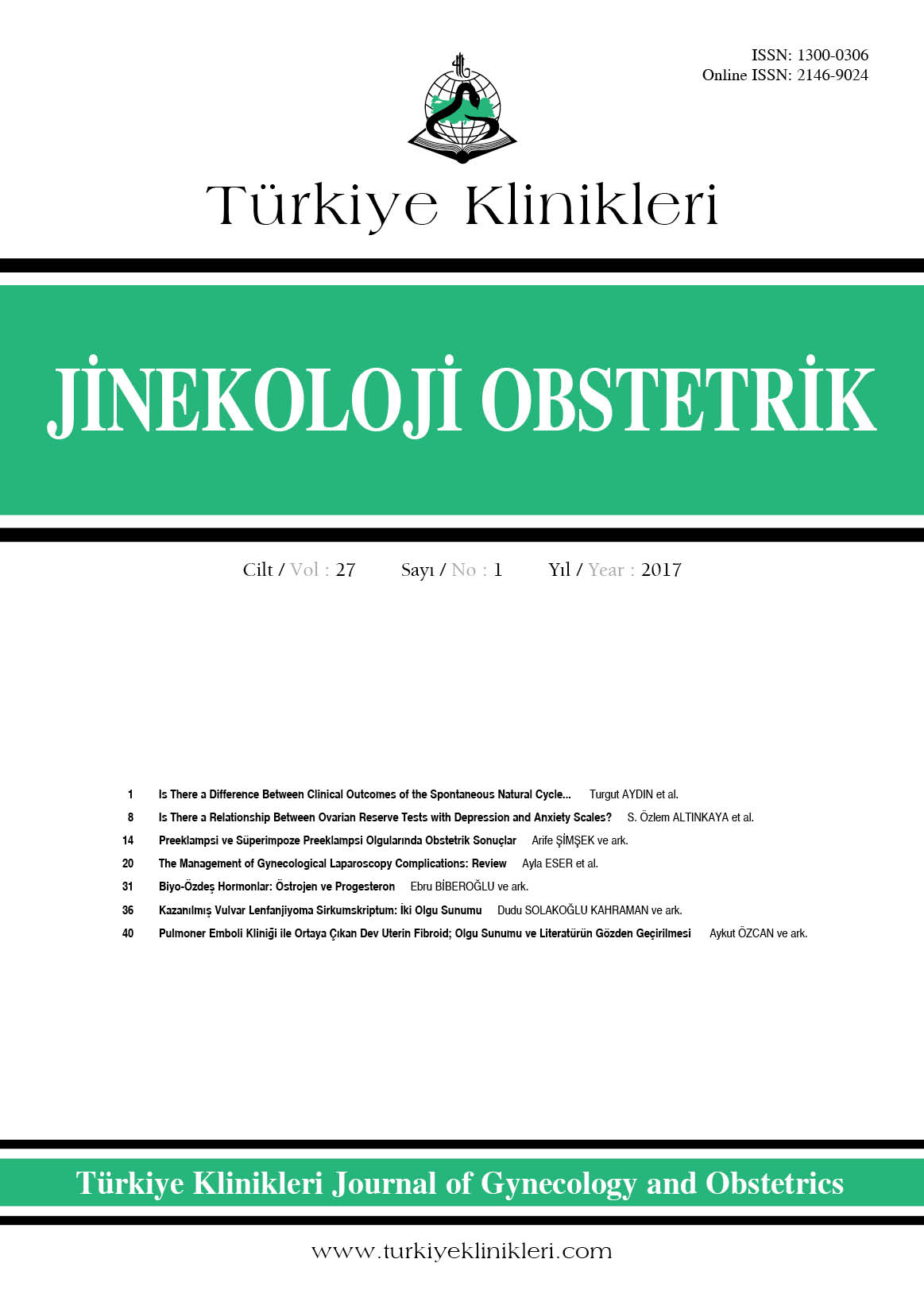Open Access
Peer Reviewed
ORIGINAL RESEARCH
2631 Viewed1355 Downloaded
Is There a Difference Between Clinical Outcomes of the Spontaneous Natural Cycle and Hormone Replacement Treatment in Frozen-Thawed Human Embryo Transfer?
Dondurulmuş-Çözülmüş İnsan Embriyo Transferinde Klinik Sonuçlar Açısından Spontan Doğal Siklus ve Hormon Replasman Tedavisi Arasında Fark Var mı?
Turkiye Klinikleri J Gynecol Obst. 2017;27(1):1-7
DOI: 10.5336/gynobstet.2016-54275
Article Language: EN
Article Language: EN
Copyright Ⓒ 2025 by Türkiye Klinikleri. This is an open access article under the CC BY-NC-ND license (http://creativecommons.org/licenses/by-nc-nd/4.0/)
ABSTRACT
Objective: Frozen-thawed embryo transfer can be accomplished during a natural cycle after spontaneous ovulation or after artificial preparation of endometrium with exogenous steroids. The implantation, pregnancy and live birth rates following frozen-thawed embryo transfer (FET) were compared between in a natural and hormonal control cycle. Material and Methods: This single-center, retrospective trial was implemented on data derived from a series of 244 women who had successful FET in our tertiary care center between January 2012 and June 2015. Two groups were constituted: Group 1 consisted of 101 women who underwent FET after spontaneous ovulation; while 143 women had FET after endometrial preparation with hormone replacement therapy. Rates of implantation, clinical pregnancy, and live birth were compared between two groups. Results: Two groups were similar on baseline characteristics (maternal ages at time of freezing and transfer of embryos, the number of previous fresh and frozen embryo transfer cycles, the number of oocytes and mature oocytes obtained in natural cycles) (p>0.05). There was no difference between 2 groups regarding rates of clinical pregnancy (p=0.13), implantation (p=0.19) and live birth (p=0.26). Conclusion: The findings of this study indicated that the clinical outcomes were comparable between the spontaneous natural cycle and hormone replacement treatment in FET.
Objective: Frozen-thawed embryo transfer can be accomplished during a natural cycle after spontaneous ovulation or after artificial preparation of endometrium with exogenous steroids. The implantation, pregnancy and live birth rates following frozen-thawed embryo transfer (FET) were compared between in a natural and hormonal control cycle. Material and Methods: This single-center, retrospective trial was implemented on data derived from a series of 244 women who had successful FET in our tertiary care center between January 2012 and June 2015. Two groups were constituted: Group 1 consisted of 101 women who underwent FET after spontaneous ovulation; while 143 women had FET after endometrial preparation with hormone replacement therapy. Rates of implantation, clinical pregnancy, and live birth were compared between two groups. Results: Two groups were similar on baseline characteristics (maternal ages at time of freezing and transfer of embryos, the number of previous fresh and frozen embryo transfer cycles, the number of oocytes and mature oocytes obtained in natural cycles) (p>0.05). There was no difference between 2 groups regarding rates of clinical pregnancy (p=0.13), implantation (p=0.19) and live birth (p=0.26). Conclusion: The findings of this study indicated that the clinical outcomes were comparable between the spontaneous natural cycle and hormone replacement treatment in FET.
ÖZET
Amaç: Dondurulmuş-çözülmüş embriyo transferi ovulasyon sonrası doğal siklus veya endometriyumun dışarıdan steroidler ile hazırlanması sonrası gerçekleştirilebilir. Doğal siklus ve hormonal kontrollü siklus arasında dondurulmuş-çözülmüş embriyo transferi sonrası implantasyon, gebelik ve canlı doğum oranları karşılaştırıldı. Gereç ve Yöntemler: Bu tek merkezli, retrospektif çalışma bizim üçüncü basamak merkezimizde, Ocak 2012-Haziran 2015 tarihleri arasında başarılı şekilde donmuş embriyo transferi yapılmış olan 244 hasta verisinden gerçekleştirildi. Çalışmada 2 grup oluşturuldu: Grup 1 spontan ovulasyon sonrası donmuş embriyo transferi yapılmış olan 101 kadını içerirken; Grup 2 hormonal replasman tedavisi ile endometriyal hazırlık sonrası donmuş embriyo transferi yapılan 143 hastayı içermektedir. Gruplar implantasyon, klinik gebelik ve canlı doğum oranları açısından karşılaştırıldı. Bulgular: Temel özellikler açısından iki grup birbirine benzerdi (embriyo dondurma ve embriyo transferi sırasındaki maternal yaş, önceki taze ve dondurulmuş embriyo transfer siklus sayısı, doğal sikluslarda elde edilen oosit ve olgun oosit sayıları) (p>0,05). İki grup arasında klinik gebelik (p=0,13), implantasyon (p=0,19) ve canlı doğum (p=0,26) oranları açısından fark yoktu. Sonuç: Bu çalışmanın bulguları dondurulmuş embriyo transferi işleminde doğal siklus ve hormon replasman tedavisinin klinik sonuçlarının benzer olduğunu gösterdi.
Amaç: Dondurulmuş-çözülmüş embriyo transferi ovulasyon sonrası doğal siklus veya endometriyumun dışarıdan steroidler ile hazırlanması sonrası gerçekleştirilebilir. Doğal siklus ve hormonal kontrollü siklus arasında dondurulmuş-çözülmüş embriyo transferi sonrası implantasyon, gebelik ve canlı doğum oranları karşılaştırıldı. Gereç ve Yöntemler: Bu tek merkezli, retrospektif çalışma bizim üçüncü basamak merkezimizde, Ocak 2012-Haziran 2015 tarihleri arasında başarılı şekilde donmuş embriyo transferi yapılmış olan 244 hasta verisinden gerçekleştirildi. Çalışmada 2 grup oluşturuldu: Grup 1 spontan ovulasyon sonrası donmuş embriyo transferi yapılmış olan 101 kadını içerirken; Grup 2 hormonal replasman tedavisi ile endometriyal hazırlık sonrası donmuş embriyo transferi yapılan 143 hastayı içermektedir. Gruplar implantasyon, klinik gebelik ve canlı doğum oranları açısından karşılaştırıldı. Bulgular: Temel özellikler açısından iki grup birbirine benzerdi (embriyo dondurma ve embriyo transferi sırasındaki maternal yaş, önceki taze ve dondurulmuş embriyo transfer siklus sayısı, doğal sikluslarda elde edilen oosit ve olgun oosit sayıları) (p>0,05). İki grup arasında klinik gebelik (p=0,13), implantasyon (p=0,19) ve canlı doğum (p=0,26) oranları açısından fark yoktu. Sonuç: Bu çalışmanın bulguları dondurulmuş embriyo transferi işleminde doğal siklus ve hormon replasman tedavisinin klinik sonuçlarının benzer olduğunu gösterdi.
MENU
POPULAR ARTICLES
MOST DOWNLOADED ARTICLES





This journal is licensed under a Creative Commons Attribution-NonCommercial-NoDerivatives 4.0 International License.










